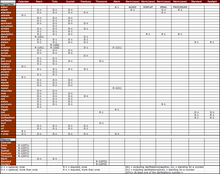iCalendar
With supporting software, such as an email reader or calendar application, recipients of an iCalendar data file can respond to the sender easily or counter-propose another meeting date/time.
For example, certain events can be sent by traditional email or whole calendar files can be shared and edited by using a WebDav server, or SyncML.
Simple web servers (using just the HTTP protocol) are often used to distribute iCalendar data about an event and to publish busy times of an individual.
iCalendar is heavily based on the earlier vCalendar by the Internet Mail Consortium (IMC) which has the .vcs file extension.
A first effort to simplify iCalendar standards by the IETF "Calendaring and Scheduling Working Group" (ietf-calsify WG) ended in January 2011 without seeing adoption.
The equivalent file type codes in Apple Macintosh operating system environments are iCal and iFBf.
This standard defines methods such as PUBLISH, REQUEST, REPLY, ADD, CANCEL, REFRESH, COUNTER (to negotiate a change in the entry), and DECLINE-COUNTER (to decline the counter-proposal).
Here is a simple example of an iCalendar object with a single calendar containing a single Calendar Component, a "Bastille Day Party" event starting at 5pm on July 14, 1997, and ending at 4am the following morning:[10] The UID field distributes updates when a scheduled event changes.
[11] The most common representation of date and time is a tz timestamp such as 20010911T124640Z with the format
[13] Components include: iCalendar is meant to "provide the definition of a common format for openly exchanging calendaring and scheduling information across the Internet".
vCalendar and iCalendar support private software extensions, with a "X-" prefix, a number of which are in common usage.
hEvent is an HTML representation of a subset of iCalendar data using microformats addressing some accessibility concerns with the hCalendar format.
